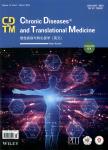Preoperative serum lipid profile and outcome in nonmetastatic colorectal cancer
Preoperative serum lipid profile and outcome in nonmetastatic colorectal cancer作者机构:Department of Medical 0ncology Affiliated Hospital of Jiangnan University and Wuxi 4th People's Hospital Wuxi Jiangsu 214062 China
出 版 物:《Chronic Diseases and Translational Medicine》 (慢性疾病与转化医学(英文版))
年 卷 期:2016年第2卷第4期
页 面:-页
学科分类:1002[医学-临床医学] 100214[医学-肿瘤学] 10[医学]
主 题:Colorectal cancer Overall survival Prognostic model Serum lipids
摘 要:OBJECTIVE:A large portion of non-metastatic colorectal cancers (non-mCRCs) recur after curative surgery. In addition to the traditional tumor-related factors, host-related factors are also required to accurately predict prognosis. A few studies have shown an association between the serum lipid profile and the survival and treatment response of patients with colorectal cancer.;METHODS:We retrospectively evaluated the prognostic significance of the preoperative serum lipid profile [total cholesterol (TC), triglyceride (TG), low-density lipoprotein cholesterol (LDL-C), and high-density lipoprotein cholesterol (HDL-C)] in patients with non-mCRC treated with curative surgery. The Spearman rank correlation test was used to analyze associations between lipid levels and categorical variables. Lipid levels were modeled as four equal-sized quartiles based on the distribution among the whole cohort. Kaplan-Meier curves were used to estimate survival probabilities, and the log-rank test was used to detect differences between them. Multivariate fractional polynomial (MFP) analysis was used to model any non-linear effects and avoid categorization. To evaluate the added prognostic value of lipids, the predictive power of two models (with and without lipids as covariates) was compared by using Harrell s C-statistic and the Akaike information criterion (AIC).;RESULTS:A total of 266 patients with non-mCRC were enrolled in the present study. Spearman rank correlation test showed that TG levels inversely correlated with N stage ( = -0.20, = 0.00) and Tumor-Node-Metastasis (TNM) stage ( = -0.19, = 0.00). HDL-C levels positively correlated with perineural invasion (PNI) ( = 0.15, = 0.02), and LDL-C levels inversely correlated with lymphovascular invasion (LVI) ( = -0.12, = 0.04). None of the four lipids predicted overall survival (OS) in univariate or multivariate analyses adjusted for age, gender, T stage, N stage, TNM stage, histological grade, tumor deposits, LVI, PNI, and adjuvant treatment (all 0.05). In agreement, the Kaplan-Meier curves for OS according to the lipid quartiles were not significantly different, as confirmed by the log-rank test (all 0.05). MFP analysis also found no significant associations between lipid levels and OS (all 0.05). A prognostic model that included lipids had a higher Harrell s C-statistic and a lower AIC value than did a model that did not include lipids (for Harrell s C-statistic: 0.82 . 0.77; for AIC: 398 . 432).;CONCLUSIONS:Measuring preoperative serum lipid levels may be a simple and cost-effective way of increasing prognostic accuracy in patients with non-mCRC treated with curative surgery.



